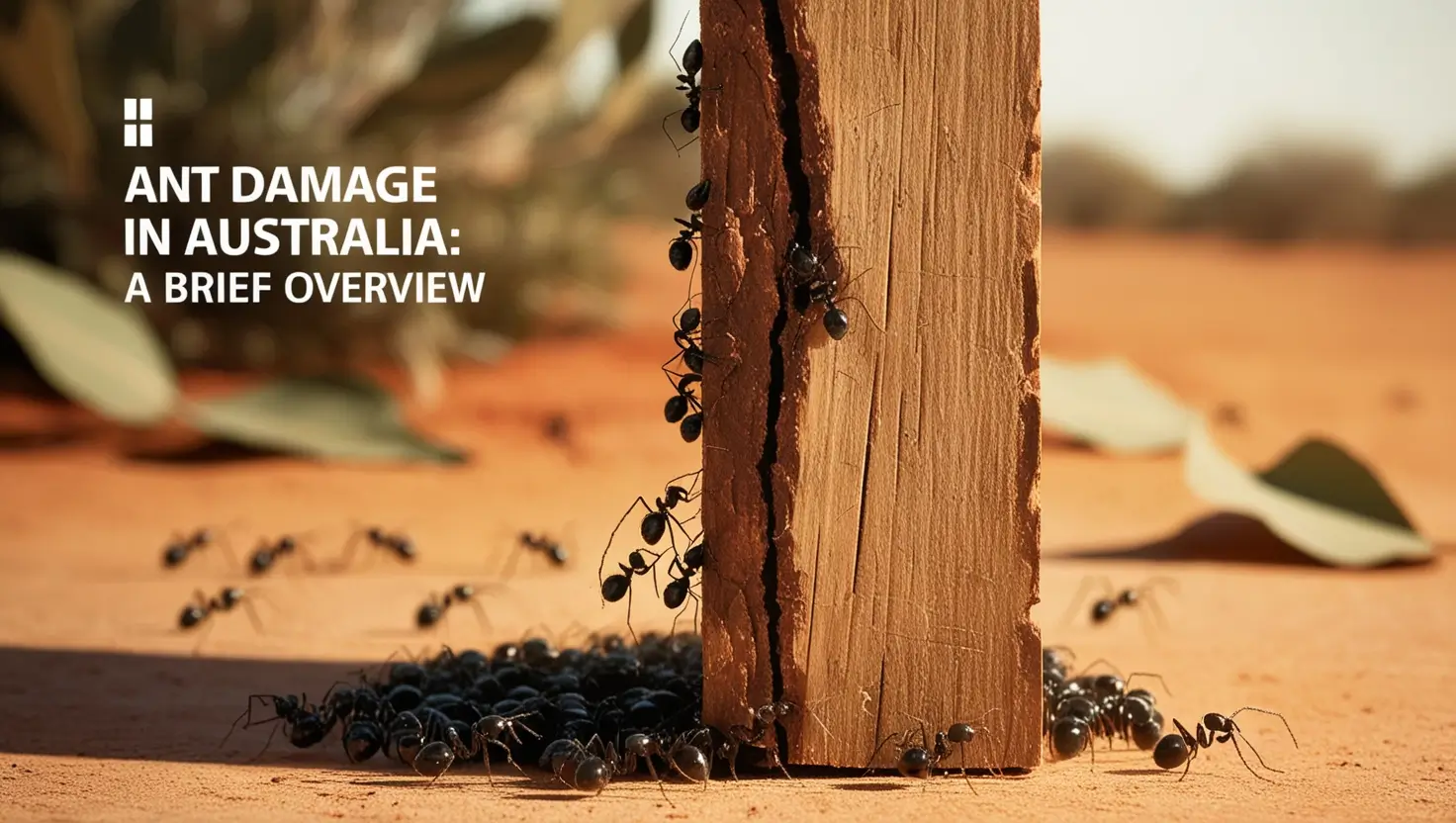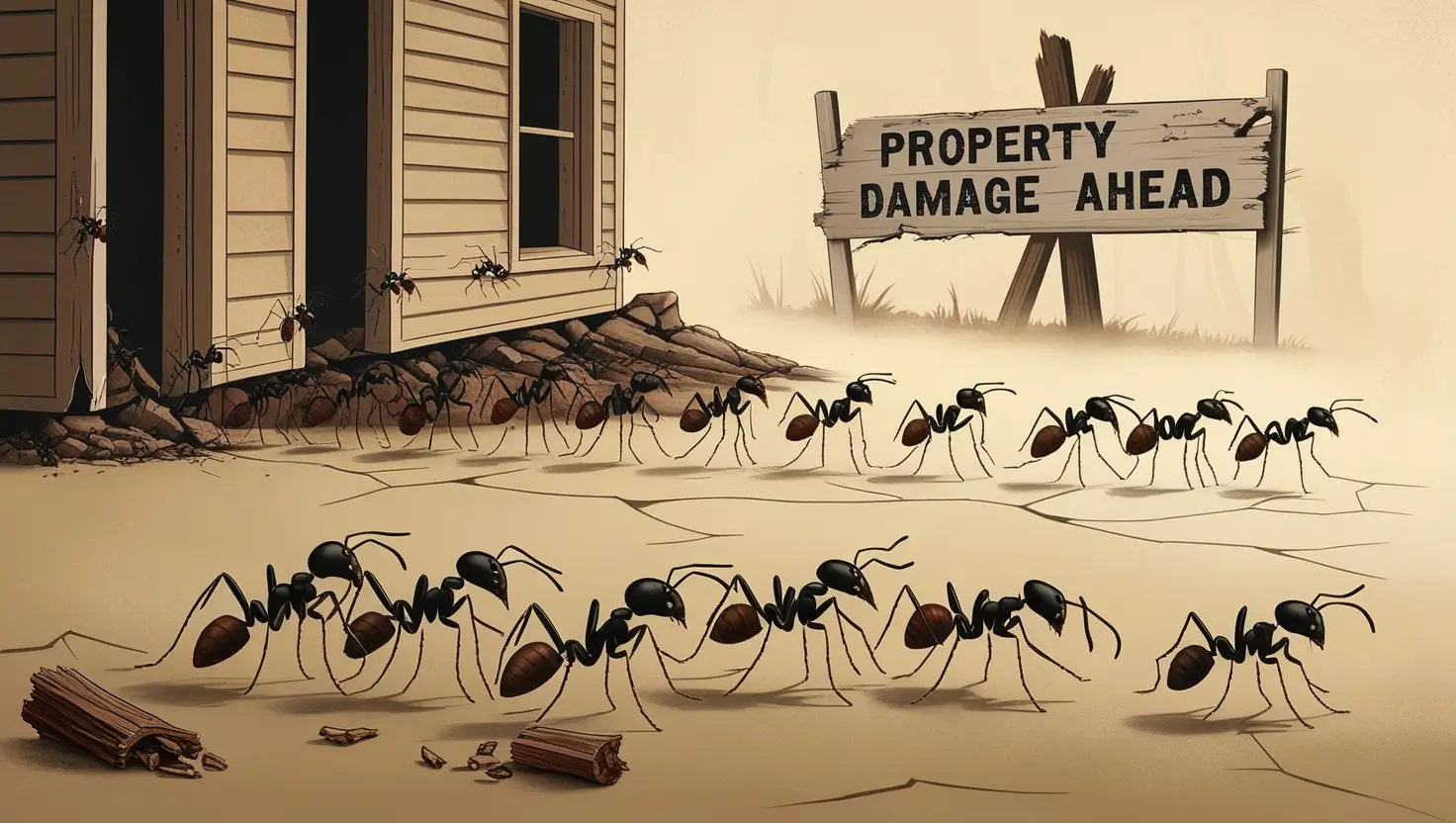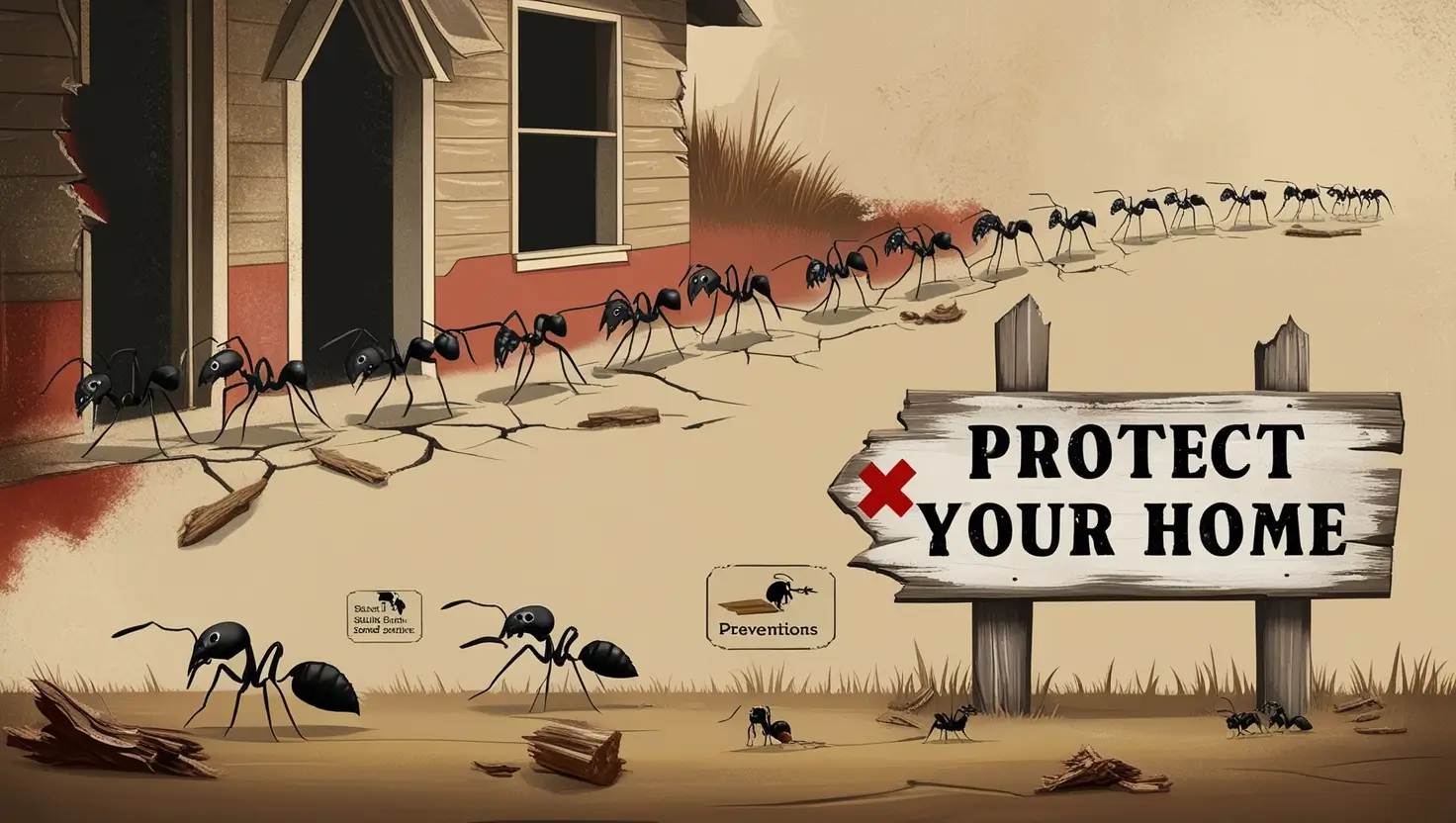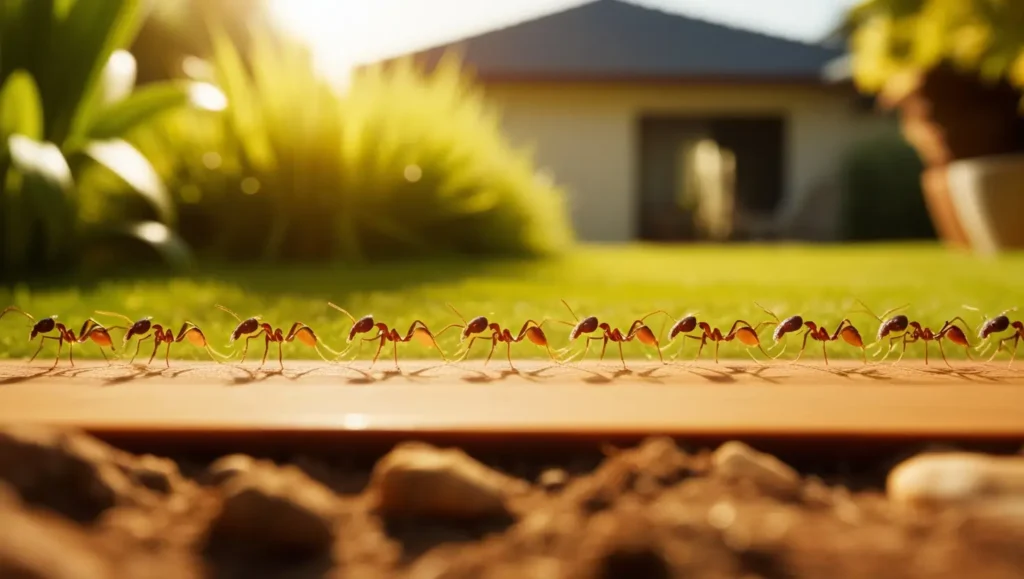Ant damage is a common factor nowadays. Ants may seem like small, harmless creatures, but in Australia, they can cause significant damage to your property. Whether it’s structural damage, electrical faults, or even garden destruction, ants can become a serious problem if left unchecked.
This comprehensive guide will help you understand the various ways ants can damage your property, identify signs of an infestation, and take steps to protect your home. Plus, we’ll provide internal links to additional resources that you might find helpful in maintaining a pest-free environment.
Understanding the Common Types of Ants in Australia
Australia is home to several ant species, but some are more likely to damage your property than others. Knowing the types of ants that could invade your home is essential to prevent damage effectively.
| Ant Species | Potential Damage | Identification Tips |
|---|---|---|
| Carpenter Ants | Structural damage by excavating wood to create nests. | Look for small piles of wood shavings (frass) near wooden structures, hollow sounds when tapping on wood, or visible galleries along wooden surfaces. |
| Argentine Ants | Contaminate food supplies, protect pests that damage plants, and cause garden damage. | Small, light to dark brown ants that form large trails indoors and outdoors. |
| Coastal Brown Ants | Damage food stores, disturb soil around structures, potentially causing foundation destabilization. | Identified by their reddish-brown color, often found near entry points or kitchen areas. |
| Fire Ants | Inflict painful stings, cause allergic reactions, damage electrical equipment, and pose a significant health risk. | Red or reddish-brown color, aggressive, and form visible mounds outdoors. |
For more detailed information on dealing with pests such as carpenter bees and bumble bees, check out our guide on carpenter bee vs. bumble bee – what’s the difference in Australia?
Ant Damage in Australia: A Brief Overview

Ants might seem like minor nuisances, but in Australia, they can cause serious problems for homeowners, businesses, and farmers. This summary outlines the key ways ants can damage property and the costs associated with dealing with these pests.
1. Structural Damage
Key Culprits: Carpenter Ants
Carpenter ants are a significant threat to wooden structures. Unlike termites, they don’t eat wood; instead, they hollow it out to create their nests. This excavation weakens critical components like beams, joists, and wall studs, leading to severe structural issues over time.
- Repair Costs: Fixing carpenter ant damage can range from AUD 2,000 to AUD 10,000, depending on how widespread the problem is.
2. Electrical Hazards
Key Culprits: Fire Ants, Argentine Ants
Fire ants pose a unique danger due to their attraction to electrical currents. They can infest electrical equipment, such as circuit breakers, air conditioners, and transformers, leading to short circuits or even fires. Argentine ants also invade electrical components, especially during hot, dry weather.
- Incidents: In Queensland, fire ant-related electrical damage has resulted in repair costs of over AUD 1,500 per incident.
3. Damage to Gardens and Crops
Key Culprits: Argentine Ants, Green Tree Ants
Ants like Argentine and green tree ants protect aphids and scale insects that damage plants. This symbiotic relationship helps pests thrive, which can reduce agricultural yields and harm gardens. Additionally, ant nests can disturb soil and damage plant roots.
- Agricultural Impact: Ant infestations are costly for farmers, particularly in the horticulture and viticulture sectors, due to reduced crop yields and increased pest management expenses.
4. Health and Home Risks
Key Culprits: Fire Ants, Coastal Brown Ants
Fire ants are not just a nuisance; their painful stings can cause allergic reactions and pose risks to children and pets. Coastal brown ants frequently invade homes in search of food, contaminating surfaces and stored goods, which can lead to hygiene issues.
For a more detailed report or to access pest control guidelines, visit the Australian Government’s Pest Control Portal.
How Can Ants Damage Your Property?

Understanding the various ways ants can damage your property will help you spot the signs early and take action to prevent further harm. Here are the key areas where ants can cause damage:
1. Structural Ants Damage
Carpenter Ants are notorious for causing structural damage. Unlike termites, they do not eat wood; they excavate it to create their nests. Over time, this excavation can weaken the structural integrity of beams, joists, and other essential parts of your home. This can lead to costly repairs or, in extreme cases, major renovations.
How to Spot Structural Damage: Look for small piles of wood shavings near wooden structures, hollow sounds when tapping on wood, or visible galleries running along wooden surfaces.
For more insights into identifying early warning signs of other pests that can damage your home, see our article on early warning signs of termite infestation.
2. Electrical Ants Damage
Certain ant species, like fire ants, are attracted to electricity. They can infest electrical appliances and wiring, chewing through insulation and short-circuiting connections, which can even lead to fires. Electrical damage caused by ants is not only costly but also poses a significant safety risk.
How to Spot Electrical Damage: Watch for flickering lights, malfunctioning appliances, or visible signs of ants near electrical outlets, circuit boxes, or wiring.
To learn about dealing with other pests that can cause damage to your home’s infrastructure, explore our post on how rodents can be controlled at home in Perth: step-by-step guide.
3. Garden and Lawn Ants Damage
Ants can also wreak havoc on your garden and lawn. Argentine ants and coastal brown ants often protect aphids and scale insects that feed on your plants. By fending off the natural predators of these pests, ants indirectly cause damage to your garden. Additionally, ant nests can uproot plants and disturb soil, causing further damage.
How to Spot Garden Damage: Look for wilting plants, a high number of aphids or scale insects, and small mounds of disturbed soil in your garden.
4. Contamination of Food Supplies
Ants are opportunistic feeders, and species like coastal brown ants and Argentine ants are notorious for invading homes in search of food. They contaminate food supplies, leading to waste and potential health risks. Their presence can be especially problematic in kitchens and pantries where they can infiltrate food storage.
How to Spot Contamination: Look for ant trails leading to food sources, entry points like cracks and crevices, or small dark specks (ant droppings) near food storage areas.
Signs of an Ant Infestation
Recognizing an ant infestation early is crucial for preventing extensive damage. Common signs include:
- Visible Ant Trails: Regular ant traffic in and around your home indicates a nearby nest.
- Discarded Wings: Swarmer’s (reproductive ants) shed their wings after mating. Piles of wings near windows or doorways suggest a nearby nest.
- Rustling Noises: In quieter areas, you might hear rustling sounds from within walls or ceilings where ants are nesting.
- Wood Shavings or Frass: Piles of fine, sawdust-like material around wooden structures indicate carpenter ants are present.
For additional insights into common household pests, visit our article on the top 15 common household bugs in Australia.
Prevention Tips to Protect Your Home From Ants Damage

Preventing ants from entering your property is always better than dealing with an infestation. Here are some tips to keep your home ant-free:
1. Maintain a Clean Home
Regular cleaning is your first line of defense against ants. Ensure that food crumbs and spills are promptly cleaned, and store food in airtight containers. Focus on kitchen counters, dining areas, and food storage spaces.
2. Seal Entry Points
Ants can enter your home through even the smallest cracks. Inspect your property for gaps around windows, doors, and utility pipes, and seal them with caulk or weather stripping. Repair any damaged screens and replace broken tiles or siding.
3. Eliminate Moisture Sources
Ants, like most pests, are attracted to moisture. Fix leaks in your plumbing, roof, or gutters to prevent water from accumulating around your property. Keep basements, attics, and crawl spaces well-ventilated and dry.
4. Trim Vegetation
Ants often use vegetation as a bridge to your home. Keep trees and shrubs trimmed back, and ensure that mulch and soil are not piled against your foundation. This reduces the number of natural pathways for ants to enter your property.
5. Regular Inspections and Professional Help
Even with the best preventative measures, ants can still find their way into your home. Regular inspections by a professional pest control service can help identify early signs of infestation and prevent damage. A professional service will have the tools and expertise to effectively treat the problem and ensure ants do not return.
To understand the importance of routine pest inspections, read our article on the importance of regular pest inspections for Perth homes.
How Our Professional Pest Control Service Can Help
If you’re dealing with an ant infestation or are concerned about potential damage, professional help is the best course of action. At Loins Pest and Weed Control, we provide comprehensive pest control solutions tailored to your needs. Our experienced team uses the latest techniques and eco-friendly products to eliminate ants and protect your home from future invasions.
- Thorough Inspection: We start with a detailed inspection to identify the type of ant and the extent of the infestation.
- Targeted Treatment: Our treatments are designed to effectively eliminate ants at their source, ensuring long-term protection.
- Prevention Plan: We provide a customized prevention plan to keep ants from coming back, including recommendations for home maintenance and follow-up visits.
Final Word: Protect Your Home from Ants Damage Today
Ants may be small, but the damage they can cause is significant. From structural and electrical damage to contamination and garden destruction, ants pose a real threat to Australian homeowners. By understanding the risks, recognizing the signs of an infestation, and taking preventative measures, you can protect your property from costly repairs.
Don’t wait until it’s too late. If you’re worried about ants damaging your home, contact Loins Pest and Weed Control today. Let us help you keep your home safe, secure, and ant-free.

